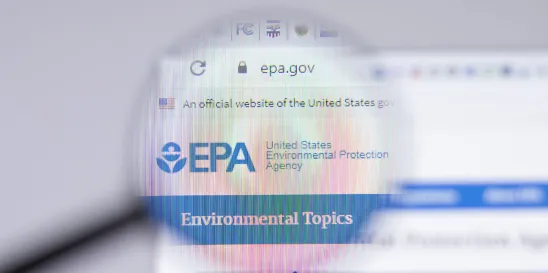The U.S. Environmental Protection Agency’s (EPA) Office of Inspector General (OIG) issued on November 15, 2023, its report on EPA’s fiscal year (FY) 2024 top management challenges. OIG states that the report “summarizes what the inspector general considers to be ‘the most serious management and performance challenges facing the agency’” for FY 2024 and briefly assesses EPA’s progress in addressing those challenges. According to OIG, the management challenges include “Safeguarding the Use and Disposal of Chemicals”:
- Providing Timely Chemical Assessments: OIG notes that both the Toxic Substances Control Act (TSCA) and the Federal Insecticide, Fungicide, and Rodenticide Act (FIFRA) require risk assessments of chemicals and pesticides within statutorily mandated deadlines. OIG summarizes the following obstacles to EPA’s timely completion of assessments “arising from increased requirements and looming deadlines that strain its personnel and other resources”:
- Frank R. Lautenberg Chemical Safety for the 21st Century Act (Lautenberg Act): The Lautenberg Act amended TSCA in 2016, expanding EPA’s regulatory authority to include the prioritization, selection, risk assessment, and potential regulation of the more than 70,000 existing chemicals already in commerce. It also requires EPA to make affirmative risk determinations on 100 percent of new chemical notices submitted under TSCA Section 5, “which is about a fivefold increase in the Agency’s workload.” OIG notes that the Office of Chemical Safety and Pollution Prevention’s annual budget has not kept pace with added workload demands, however.
- FIFRA: FIFRA requires EPA to review each registered pesticide every 15 years. The initial review was to be completed by October 1, 2026, in the case of pesticides registered before October 1, 2007. According to OIG, as of April 2023, a total of 789 pesticide cases had that registration review deadline. OIG states that EPA has been unable to complete all required registration review processes, and the backlog impedes its ability to ensure the safety of older pesticides. To meet its strategic goal of supporting pesticide safety training for 20,000 farmworkers annually by September 30, 2026, EPA must address the challenge of providing information to transient workers of varying cultural and language backgrounds. EPA must also adapt to the updated and amended Pesticide Registration Improvement Act (PRIA), requiring EPA to improve the electronic registration process and to establish a voucher program to incentivize expedited reviews of new insecticides designed to control the spread of vectorborne diseases.
- Addressing Additional Concerns Related to Ensuring the Safety of Chemicals: OIG notes that its 2021 evaluation of EPA’s Endocrine Disruptor Screening Program (EDSP) found that EPA “has not made meaningful progress in complying with the Federal Food, Drug, and Cosmetic Act’s statutory requirement to test all pesticides for endocrine-disruptor activity.” When EPA registers or reevaluates a pesticide, the Endangered Species Act (ESA) requires it to ensure that the agent does not jeopardize threatened or endangered species or their habitats. According to OIG, the Office of Pesticide Programs (OPP) “still needs to review over 1,000 active ingredients, according to the office’s Endangered Species Act work plan, published in April 2022.”
- Safeguarding Waste Disposal, Restoring Land, and Revitalizing Communities:
- The Superfund, Hazardous Waste, and Emergency Response: According to OIG, nearly one-quarter of the U.S. population lives within three miles of a Superfund site. OIG notes that this population “is more minority, low-income, linguistically isolated, and less likely to have a high school education than the U.S. population in general,” according to EPA. Emergency response and deployment are part of EPA’s Superfund mandates, but unexpected environmental emergencies require abrupt shifts of EPA staff and resources away from other priorities and cleanup efforts. OIG states that it found that EPA struggles to meet statutory and policy inspection requirements. Broader efforts related to combating the threat of climate change will also create challenges for EPA, such as the rise in popularity of electric vehicles, which creates potential difficulties for managing batteries as a growing waste stream.
- Per- and Polyfluoroalkyl Substances (PFAS): According to OIG, EPA is facing a challenge to study and assess the potential human health and environmental risks associated with PFAS. OIG notes that “[t]he continuing challenges for PFAS treatment technologies are the cost and the lack of methods and guidance, as well as full-scale disposal techniques that are fully effective.”
OIG concludes that for EPA to protect public health effectively from the risks of using and disposing of chemicals, “it will need to be able to conduct credible and timely chemical risk assessments, effectively oversee and safeguard the management of a variety of chemical wastes through regulated containment and disposal actions, and efficiently respond to and remediate any unexpected chemical releases or spills.” According to OIG, EPA is challenged by a lack of resources and stringent statutory deadlines. OIG notes that unpredictable events, such as chemicals spills resulting from infrastructure degradation or stronger storms and flooding because of climate change, also directly impact EPA’s ability to provide for all necessary cleanup and remediation efforts.




 />i
/>i

